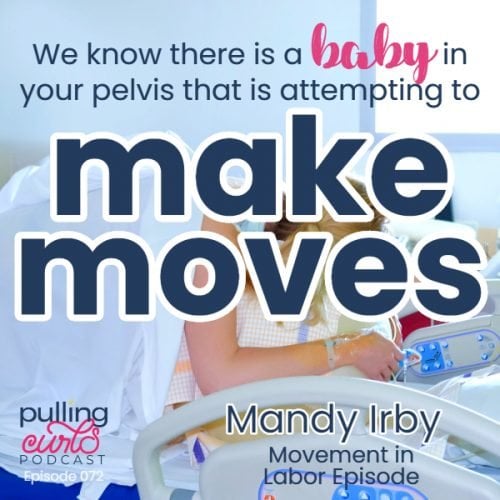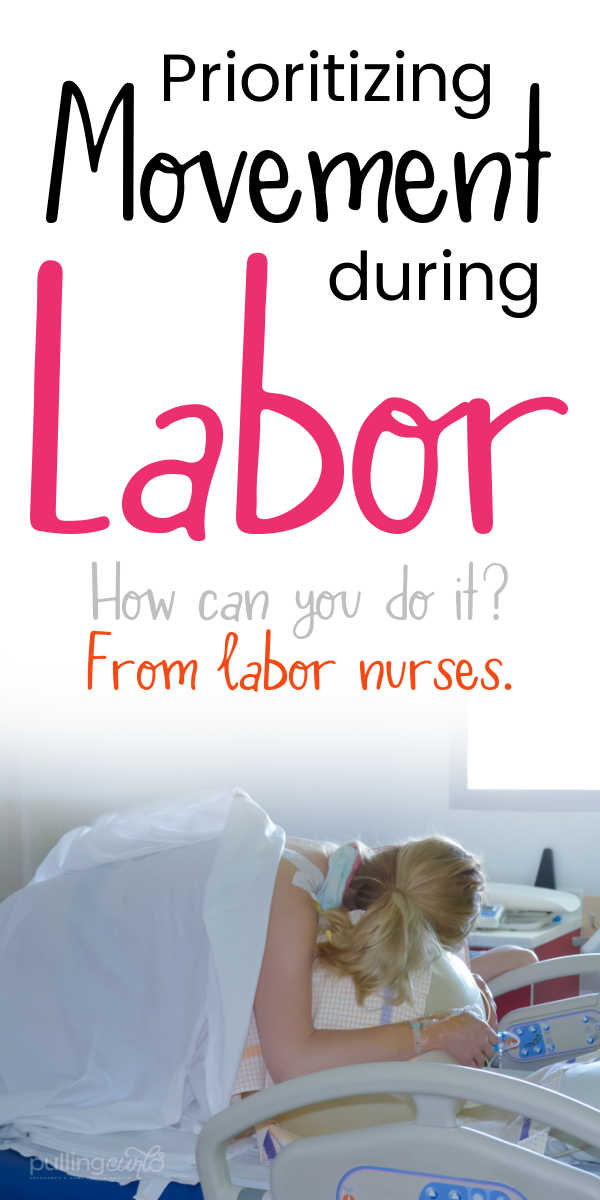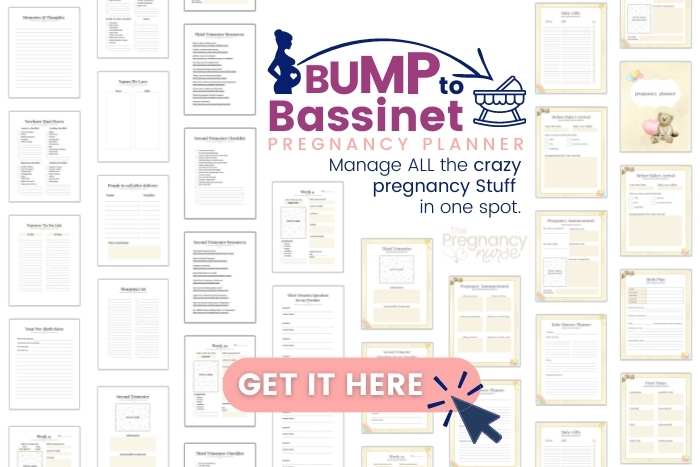
Moving during labor is one of the most important things you can do help the labor process. But, how do you do it at home, in the hospital or if you have an epidural
Today’s guest is Mandy Irby (second time Mandy is on, she was also on this episode on how to go into labor and this one on saying no). She’s The Birth Nurse on Youtube and on Instagram and does trauma-sensitive nursing and childbirth education in the Roanoake, VA area (and also does Spinning Babies classes — which are super cool).
Big thanks to our sponsor The Online Prenatal Class for Couples — I’m going to help you partner support you and remind you of all these priorities once you’re in labor. I think you’ll love it!
Moving During Labor
In this episode
Why you might not prioritize movement during labor
How your partner can help you move during labor
How you can move when you’re in labor at home
How you can prioritize movement in the hospital
Wireless monitors in labor
Walking Epidurals (find out all my info on epidurals here)
Ronco Rotissarie Chicken maker
How your partner can help move you when you have an epidural (and how their engagement can help your staff move you more).
How a peanut ball can help
WHY you need to move and what it does to help your baby come out
What nurses can and can’t do for you and your movement during labor
How frequently you will be moving in labor
How to balance rest and movement in labor
Why movement can help your epidural
Other things that might interest you
Producer: Drew Erickson
Check out my other pregnancy podcasts:

Check out all my podcasts:
Transcript
[00:00:00.390] – Hilary Erickson
Hey, guys, welcome back to Episode 72. Today, we are talking about one of the most important things to do in labor. We’re talking about moving it and grooving it. Let’s untangle it.
[00:00:25.290] – Hilary Erickson
Welcome to the Pulling Curls Podcast, I’m Hilary, your curly headed host on the podcast where we untangle everything from pregnancy, parenting and home routines. I want you to know that there are no right answers for every family. And I find that simplifying my priorities is almost always the answer. It’s tangled just like my hair.
[00:00:50.270] – Hilary Erickson
OK, guys, today’s guest is my good friend, Mandy. This is her third time on the pulling curls podcast , if you don’t remember, she is the birth nurse on the interwebs. She teaches nurses and patients about how to make labor better for both of us. So I want to introduce my friend Mandy Irby.
[00:01:07.490] – Hilary Erickson
This episode of The Pulling Curls Podcast is sponsored by the online prenatal class. For couples, it simplifies understanding labor so you can have a more relaxed pregnancy and birth taught by a highly experienced labor and delivery nurse and can be done wherever you are, whenever you want. No more arranging busy schedules to fit in a prenatal class, save 15 percent with the coupon code UNTANGLED. You can find out more at Pulling Curls Podcast and the menu under courses or in this episode, show notes.
[00:01:34.520] – Hilary Erickson
Hey Mandy, welcome back to the Pulling Curls Podcast.
[00:01:37.990] – Mandy Irby
Hey, Hilary, thanks for having me.
[00:01:39.680] – Hilary Erickson
You are a third timer.
[00:01:42.680] – Mandy Irby
Really?
[00:01:43.550] – Hilary Erickson
Three times? I’m pretty sure we’ve done… This is our third time.
[00:01:47.120] – Mandy Irby
We talk a lot.
[00:01:48.710] – Hilary Erickson
It’s not going to be our last either. I got to say that. So, OK, so today we’re talking about movement during labor and you guys are going to think, well, of course I’m going to move. I move all the time. Right? Which is awesome. You should. I’m a big fan of prenatal yoga. Did you do yoga when you’re pregnant?
[00:02:04.610] – Mandy Irby
Heck yeah, I did!
[00:02:05.540] – Hilary Erickson
Yeah.
[00:02:06.320] – Mandy Irby
Ask me how many times I’ve done it since?
[00:02:08.780] – Hilary Erickson
I do yoga now…
[00:02:10.580] – Mandy Irby
Do it.
[00:02:11.000] – Hilary Erickson
Yeah, once a week. I do not… I do not like yoga. Let me just state that. It’s a little too slow and deliberate for this one.
[00:02:19.460] – Mandy Irby
Yeah. Yeah. It requires a lot of mental exercise for me.
[00:02:24.740] – Hilary Erickson
Yeah. Too much feeling talk for me. But yes, movement is super important while you’re in labor. But when you’re in pain, how many of us like when I had kidney stones do you think I just wanted to run around and do some lunges? No. I wanted to ball up on my bed and cry and vomit.
[00:02:44.090] – Mandy Irby
Not move.
[00:02:44.780] – Hilary Erickson
Yeah, it’s just not your first reflex when you’re when you’re in pain, it’s like, let’s move some more. So I think it’s really important to get your partner on board with this one because you’re going to have that first reflex to just lay around. And they might have to be like and they might have to support you because it feels good to like do the bare, like you’re back in junior high dance doing the bear hide dance pose. So it feels good to, like, hold on to that partner during movement. What do you think?
[00:03:10.670] – Mandy Irby
Yes, I definitely agree. My partner would definitely be like, OK, whatever you think is right, if you don’t want to move. Unless I specifically said make me get up.
[00:03:21.650] – Hilary Erickson
Yeah.
[00:03:22.430] – Hilary Erickson
Right? You need like a code word for like no for real. I’m not going to get up. But for the most part, it helps to have encouragement and it helps to have someone who can keep you doing it.
[00:03:31.310] – Hilary Erickson
Yeah. And then one of our other episodes on how to go into labor, we talked to Curb Walking. We talked sexy hip circles. So all those are great zudu in early labor. What even once you know you’re in labor, you probably wouldn’t have it in me to curb walk. That sounds really uncomfortable, but sexy hip circles on a yoga ball feels good because it also helps to stretch out those hips and all that jazz. But when you get to the hospital, then you’ve got a whole other bag of chips because in our cells, this monitor strapped to you. So, Mandy, what are some ways you encourage patients to move once they’re at the hospital?
[00:04:00.290] – Mandy Irby
Oh, gosh, I continue to encourage creative ways of movement. You’re not going to find a lot of curves in your labor room. And it is difficult to find stairs even in a lot of places, but it usually still feels good. Better to move than to be stuck in the bed. And you don’t really realize that, or most of my patients don’t realize that until they are stuck in the bed or feel like they’re oh, I’m stuck.
[00:04:25.460] – Hilary Erickson
I can’t move. I’m hurting so much or I’m stuck. I can’t because I have lines coming off of me. So then when we can talk about are you actually stuck, what’s causing you to feel stuck? Can we adjust like take a bunch of stuff off of you so you don’t feel stuck? Intermittent monitoring wireless monitors lock the IV until you actually need it. Take the blood pressure cuff off. Once it’s done working, all the lines could be adjusted.
[00:04:47.000] – Hilary Erickson
So then do you feel stuck because you’re in pain? And I say, OK, if you hate it, this is what my mom said when I would say I wouldn’t want to eat, eat something, try it. If you hate it, you have to do it again. OK, deal. And they get up and I’m like, Mandy. Oh my gosh, that that sucks so badly.
[00:05:02.630] – Mandy Irby
And I love my husband says you just like being right. I say, I will not say I told you so but yes, that bed is very uncomfortable. And so they get up and then they really realize, OK, it doesn’t feel great, it didn’t make everything just magically go away. But it feels better than the alternative of not moving. Yeah, and labor pain is a different kind of pain. The Stones stones are warning you that something’s wrong and your body is sick and it’s trying to heal.
[00:05:26.090] – Mandy Irby
And it’s in it’s inflamed and it’s it’s kind of like a warning. Labor pain is work. It’s not necessarily a warning as it goes on. It’s more of this is what it feels like to work really hard to accomplish something inside your uterus. So moving with it and trying to understand and try to feel OK. Well. This still feels bad, but it feels better than when I was doing. That’s really great information. Maybe that’s helpful in helping the baby find their way.
[00:05:53.260] – Hilary Erickson
Yeah, I will say I feel like nurses are reticent to do wireless monitors. I mean, ours weren’t set up to go in our rooms. And so it did take a little work. And a lot of times I suggested to patients, but I’d have to caveat, they don’t work for everybody because ours didn’t. If you were really overweight and your thighs rubbed on your leg, a lot of times they wouldn’t work because of that. And so I’d say we are one hundred percent are going to try these things.
[00:06:16.450] – Mandy Irby
Yeah, yes. Wireless monitors are usually more work for the nurse, but what gets the nurse over the hump and I can say this because I’m a nurse and I didn’t like them, is people who say that’s what I need. I need the wireless monitor for I need to try it because this isn’t working for me. And then the nurses or the nurses either forced to me like, OK, OK, I told you about it or you know about it.
[00:06:37.840] – Mandy Irby
So I’m going to try it. I’m going to put in a good effort. And then sometimes it works and the nurses are like, oh my gosh, everyone’s so happy when it works. This is great. And it’s kind of like a positive reinforcement for the nurses or they’re forced to do it when the previous nurse did it. And that was usually me because I really, really wanted these wireless monitors to work. And I teach parents, like ask for the wireless, try to have more movement if you can try to not feel is tied down, see what options you have.
[00:07:02.230] – Mandy Irby
And I wanted to be someone that supported that and did that in the work in the hospital. So I would put them on and just practice or see if someone one of them, I’d offer them all the time. Nurses after me hated it.
[00:07:13.870] – Mandy Irby
They’re like, oh, it’s already on her and she loves it? UGH!!! That meant they had to learn how to use it.
[00:07:21.370] – Hilary Erickson
They’re slowly getting better wireless monitors. But just ask your nurse. The thing is, is a lot of patients don’t want to move and they don’t want you to bother them and they don’t want to. So you kind of get into a zone where you’re like, oh, she probably doesn’t want to. So if you come in and you want to make movement a priority, which I would suggest that you do, you might have to just be a little bit more vocal about it.
[00:07:39.310] – Hilary Erickson
I bet your nurse I’m fine to try the wireless monitor, but I always like to say it may not work. So I don’t want you to get your hopes up, but I’m going to get my best effort and that’s all we can really do.
[00:07:47.200] – Mandy Irby
Yeah, yeah. And then everyone’s on the same page, right? It’s not it’s just technology that hasn’t come as far as we had thought by now. Yeah.
[00:07:55.780] – Hilary Erickson
OK, so you have to meet once you get an epidural.
[00:07:58.630] – Hilary Erickson
Have you ever seen a walking epidural?
[00:08:00.610] – Mandy Irby
No, have you?
[00:08:01.510] – Hilary Erickson
No, I haven’t either. Oh, I think it’s just like the elusive unicorn of labor and delivery. I see people talking about it on tik tok. And I was going to be like, if you have a walking epidural, are you still in pain and you’ve just wasted your money on a needle in your back because it seems like a good walk, you’ll still feel everything.
[00:08:16.360] – Mandy Irby
So that’s no different medication. I’ve heard that they exist, but I also agree it sounds like a unicorn. It’s like where does it exist?
[00:08:23.740] – Hilary Erickson
I’ve definitely talked to anesthesia. That’s just like they’ve got the residency at big universities that are just like it doesn’t really work.
[00:08:31.300] – Mandy Irby
Yeah, most people and I’ve talked to them too. I think they don’t want me to think that they’re a thing. And it’s not like I could tell an anesthesiologist to do a walking patrol if they’re not going to do one.
[00:08:39.850] – Mandy Irby
That’s not what they offer. What I’ve heard, however, it does sound wonderful, but I think that it requires a lot of education, just like around an epidural. Everyone thinks I want an epidural because I want to feel a certain way. When you in that sentence and finish that sentence for yourself, everyone’s going to finish it with a different answer or we’re going to have a variety of answers. I don’t want to feel anything. I want to feel that I have a body.
[00:09:01.330] – Mandy Irby
I want to be able to move all the time. I still want to feel pressure. I don’t want to feel a little I want to feel a lot. We all have different expectations about an epidural. So the same with a walking up, a drill or like a less dense epidural. Some people still get that and they’re like, no, maybe I could get out of bed. And I’m like, no, really, I really can’t. We can’t test it, but they can move so well.
[00:09:20.500] – Mandy Irby
I have been almost tricked to where I wonder if they could stand. Of course I don’t. I’m like, please, no, no, no, no, no, please.
[00:09:26.800] – Mandy Irby
Worst case scenario, starting Mandy, we sold so many bones so much today.
[00:09:32.440] – Mandy Irby
We’ve never done it. But they were so they were able to move so well and they were so comfortable and it wasn’t like their Epidaurus had come out and they were hurting and able to move. You know, that’s that’s one thing that can happen. That’s where the education of the epidural comes in. People are like, I didn’t even know that could happen. Of course, that could totally happen.
[00:09:48.700] – Mandy Irby
Your epidural gets turned off accidentally kinked comes out, it’s dislocated. All of those can happen. You have been better off at this, like less dense epidural. I’ve heard. And I’ve also seen even though they weren’t called walking epidurals, they worked on labor pain. But that peroneal pressure, that pelvic or rectal pressure was still very intense at the end, which if people were expecting to be able to walk and expecting that pressure at the end, then that probably met their expectations.
[00:10:14.660] – Mandy Irby
And that’s exactly what I thought it would be. It was pretty intense, but I was still able to move and it was fine versus your expecting to feel nothing. And you’re like, what the heck is this? I have to push the baby out. And I feel all this pressure
[00:10:25.150] – Hilary Erickson
and I don’t think anesthesia and moms talk about what it’s going to be very frequently. I think they expect us to educate them. But we aren’t really sure what the anesthesia does because some of them really just want to numb you up and never hear from you again.
[00:10:37.810] – Mandy Irby
Isn’t that so true? It really depends on the doctor or the some of them are like, I’m only going to eighty percent because I want you to be able to push and I want you to move. Right. That’s a conversation that actually should happen between the birth in person and the provider, because I’m not giving the nurse the cartridge, that’s all I do if we don’t adjust it. And I think childbirth and prenatal education should happen so that those informed discussions and educated discussions can happen between the birthing person and the provider, whereas the provider and the provider might not always know what kind of how dense the is going to be there.
[00:11:11.440] – Hilary Erickson
Yeah, that’s the other problem that you never see. And we’ve even had people who wanted to do a seizure consult and you have to move all the all the world in order to be able to see anaesthesia ahead of time. So ahead of time. Right. Yeah. So there are different kinds of Epidavros walking would be cool because you can maybe get to the chair.
[00:11:29.810] – Mandy Irby
I don’t think you’re necessarily like walking around the house.
[00:11:32.530] – Hilary Erickson
Yeah, I’ve heard it’s to a commode basically, but you’re able to participate in movement in the bed a little differently. Yeah. And some I don’t want you guys to think that your epidural, your epidural shouldn’t make you numb. Sometimes it makes you numb for a couple hours. But usually those first hours I kind of let my patients have a nap. I’m not going to be like, let’s move. There’s been so tired. But I think the priority of care those first couple hours is rest and then it’s time for our Jane Fonda.
[00:11:59.300] – Mandy Irby
So. Is that what you call this?
[00:12:02.690] – Hilary Erickson
Yeah, it’s time for Jane Fonda. We’re going to move it around if people know what you’re saying, what you mean.
[00:12:10.730] – Mandy Irby
But I say we’re going to roll.
[00:12:12.620] – Mandy Irby
We’re going to we’re going to continue to move as just like before your epidural. I’m going to encourage movement. But after epidural, it’s more like a rotisserie chicken. Yeah. Where we just roll turn to Mr. Ranko. Right. The where you put the chicken on the spigot. Did you never see those infomercials? Hilary’s a lot older than Mandy.
[00:12:34.050] – Mandy Irby
I mean, I’ve seen infomercials.
[00:12:35.660] – Hilary Erickson
I just don’t know the names. A Lincoln in the show notes for everyone to see it in their spare time. I’ve been to Kroger. Well, yeah, but they sold this one that you could turn and would be on your countertop and you would just stick your chicken in and it would turn I’m going to put the link on the show and also I’m sure it’s on the YouTube’s. OK, so try to you side to side. But remember, we have extra checks.
[00:12:55.670] – Hilary Erickson
Have you guys heard a birth boss? Mandi’s the birth queen. She loves the peanut balls and birth balls. So a lot of you might have thought that you’re going to use a yoga ball, but I don’t use that that much when they’re in the bed. I feel like sometimes I do. I’ve tried it, but it’s usually it’s hard to explain. You’re not sitting on it. You’re leaning on it. Yeah. So but just ask what your job as a patient who’s listening to this podcast is to tell the nurse, I want to turn and I want to participate.
[00:13:23.300] – Hilary Erickson
You might even offer your partner to help out because sometimes, like, I can’t get another nurse to help me roll a patient and she has a dense epidural. She won’t help me move it. All the partners just sitting there flipping through Facebook. And I’m like, does anyone in this room want to get this baby out?
[00:13:40.730] – Mandy Irby
Yeah. Yeah. The baby doesn’t come through the doorway after that betrayal happens. There’s definitely some movement. And I think a lot of times people just think it’s nap time and I’m not going to have to move until this baby’s out or the nurse will just move me however she wants. But we’re not super human, right? There aren’t always a bunch of nurses just waiting to come in my door to help me move you. Right. I think that is a misconception.
[00:14:03.710] – Mandy Irby
And I have a friend whose mom is in the hospital who’s healthy and unfortunately has has been admitted to the hospital and feels horrible.
[00:14:12.320] – Mandy Irby
She has no energy. She’s so sick. And she told my friend, she said tomorrow, I hope I feel better. I want to get into the chair. And my friend said, OK, so have you tried to get in the chair yet? And her mom said, No, my IV pole won’t reach to the chair.
[00:14:30.950] – Mandy Irby
And of course, my friend is like, well, then you need a nurse to help you. So you just have to ask. But I think that’s a common misconception. When you get into the hospital, someone’s going to come in when it’s time to do that and just tell you, hey, it’s time to move to the chair. When if your pope wants to get in the chair, you say, hey, my butt wants to get in the chair, how can you and I do this together?
[00:14:50.060] – Mandy Irby
What will we need? And the nurse would then know, oh, we’re going to need a lift. We’re going to need this other person and it’ll take a few minutes. But these are the things we’re going to need. Let me collect all that and tell you when it can happen. Verse. I’ll just wait until someone tells me it’s time to turn. That could be a long time. Yeah. Yeah. And nurses. So I teach nurses, hey, let’s try to do this every thirty minutes and put it on a schedule.
[00:15:11.990] – Mandy Irby
I also teach parents because not every nurse does that. Parents, hey, set your clock and ask for help every time you want to turn because it is, it is a whole team effort to turn that often.
[00:15:22.100] – Hilary Erickson
Yeah. Because your turn and then you have to get the baby on the monitor. So it is a lot of work for a nurse to turn in sometimes, which you’re just not seeing. All those behind the scenes looks at like what the nurse is doing to make sure that it’s happening for you.
[00:15:35.000] – Hilary Erickson
Yeah. And again, like I said before, there’s a lot of patients who don’t want to turn and don’t want to be bothered by us doing it. Of course, that doesn’t keep me from not saying this is your friend, the peanut ball. He’s going to. Between your legs, that is not what I say. Hi again, reminding you, I recommend do you want to try this position or this position?
[00:15:56.430] – Mandy Irby
And if someone is really adamant and they say, Mandy, I told you, I don’t want to turn, I’m still going, I’ll turn it in 20 minutes later. I’ll say again, I’m here for you. I think that it helps because we know it helps labor, labor move forward. We know that there are joints in your pelvis that need to change shape. And we know there’s a baby in your pelvis that’s attempting to make moves, literal turning of their heads and tucking of their chins to continue to be on that cervix and continue to move down.
[00:16:22.950] – Mandy Irby
They’re being pushed by your contractions. So they’re like getting the heck out of here. I need to find my best right out and I need to do it. These contractions are telling me every few minutes it’s time to come out. So I’m going to make my moves. And if we’re just in one position, then they’re having to do all the work. It’s going to take that much longer. If we use creative positions that give movement to those bones in the pelvis, then we’re doing we’re doing our best to be the most efficient laborer that we can be.
[00:16:49.620] – Mandy Irby
So turning positions in the changing positions in the bed, sitting upright and leaning forward are things you can do with an epidural. Paintballs are mimicking kind of like a squat or a lunge position, which are really nice wide positions for the pelvis. But they’re also restful because you’re laying in the bed and you’re not actually squatting. You have an epidural. They have been shown in studies to augment labor, to improve labor patterns, the contractions, their efficiency, and to reduce the length of labor.
[00:17:16.770] – Mandy Irby
So if the goal is to have a baby and reducing your length of labor can reduce a lot of other complications that may arise with the longer labor can, we are all working working for that goal. It just should be every maybe half hour to hour instead of every two or three hours when you’re one leg is like so numb, you have no other choice but to move. Yeah, that can happen and you can bring your own ball. We’re recording the story covid.
[00:17:39.000] – Hilary Erickson
And some hospitals are saying they can’t use peanut balls because they can’t properly disinfect them, which is a little scary because they’ve been in people’s parts for years. So I was hoping we had disinfected them before. But I digress. You can’t bring your own blanket in the show notes.
[00:17:54.720] – Hilary Erickson
It’s the ones I’m looking at. You can get a dual set, but there’s one that I like that’s about 15 inches. What do you like, Mandy?
[00:18:02.280] – Mandy Irby
Oh, I go by centimeters forty, fifty or sixty centimeters. The ones on Amazon are usually a little smaller than the ones I’m used to.
[00:18:09.150] – Hilary Erickson
So we have smaller ones, probably 15 inches. We’re the ones that we use. We didn’t have a bigger one. But the other thing is also as a nurse, like I can position you, but I don’t really know how your body feels. And so if you’re kind of like this is hurting my head, there’s no way for me to know that because it’s just such a small movement that could make that comfortable, that I don’t know that because I’m not in your body.
[00:18:29.370] – Hilary Erickson
Thankfully, I’ve already had a baby. So if something’s feeling weird, tell your nurse. Right. And just be like, is there any way we could shift this way or or this labor ball is just hurting my hips. And that’s OK, too. Like I’ve used like a stepstool in the bed. I’ve used just pillows instead, or I’ll use the smaller end of the labor ball like there’s lots of different options. But we don’t know what you’re feeling.
[00:18:50.280] – Hilary Erickson
We can’t read your mind and can’t read your body. Right. That discussion is more like where are you feeling it? What’s it feel like? Is it contraction, intensity? Is it pressure?
[00:18:59.430] – Mandy Irby
Rectal pressure, baby pressure? Is it. No, my leg can’t stay like this. All things that that’s like a continuing conversation that the nurse wants to know. Yes. And some people all of a sudden I’ll be like, that’s been hurting for two hours. And I’m like, oh, my gosh, what did you tell me? You know, because I’ll say everything good. You feel fine. Yep. And then just a while there, I’ll take out the peanut to of all that was miserable.
[00:19:20.190] – Mandy Irby
And I’m like, AGH! OK, maybe there’s this, like, secret fantasy out there that your nurse is going to get your baby out if you do these certain things. Not true. Not true. No. We’re working with bodies, two bodies, a baby and a birthing person. And they need to work together. And we’re just testing things. We’re just trying out movements. There’s not necessarily unless I go in and I say, you know what?
[00:19:45.090] – Mandy Irby
I think that your baby is facing this way. And this is why I think that we’ve been doing this and this is where we still are. We’ve tried this and this is where we still are. Here’s my one or two specific positions that if you can get there and it’s comfortable, we can try it for twenty minutes. I think that might be what I would recommend is next. Unless I say that we’re just guessing mostly right. I mean, we don’t know necessarily, OK, when they say, oh my gosh, that one position was it.
[00:20:08.190] – Mandy Irby
It’s not like I waited to try it until I wanted you to have a baby. Right. I had eat my lunch, so I didn’t put you in that position. So I was ready. Yeah, I get paid more. If it’s more like between three and five then like nine and ten. No way. We want a successful birth. And that that was just the order of things that worked at that time for that person. But it’s not going to be the same the next time.
[00:20:28.590] – Mandy Irby
So we’re just trying things. And if you have an idea or if you are like, OK, I can do this, but if it’s effective, if it’s not effective, I want to get out of this position like a two contractions. That’s really great information, great communication. And then your partner standing up and being ready every time that you turn. Oh, my gosh. Makes you the person person feel so supported and seen and like less of a burden on anyone because your partner, the person you’ve chosen, is right there to help everyone.
[00:20:54.200] – Mandy Irby
And then if you try to not do it yourself because you can hurt your back and hurt yourself tomorrow, you’ll feel it. The next day you’ll feel it without enough betrayal. But just you know, I say you move your top half, I’ll help with your bottom. Right. Because actually the part that’s numb. And so your partner and I will be on separate different sides of the bed to help you turn, but not your leg fell off and to make sure you’re comfortable and safe.
[00:21:14.810] – Mandy Irby
And then it’s a team effort. It takes less time. It feels better. And emotionally, that’s like some really great support during your labor every half hour.
[00:21:21.720] – Hilary Erickson
I can feel so good. Yeah. So another thing is just expect that your epidural maybe isn’t going to make you a noodle. I always tell people you’re going to get 80 percent comfortable with your epidural. You are going to feel something so that hopefully you can still make small movements so you can adjust yourself a little bit in the bed and help the nurses when we’re making big movements. Nobody’s expecting you to do a full turn on your own. Nobody’s expecting that you’ll probably fall off the bed.
[00:21:42.470] – Mandy Irby
Right. Or one of your appendages. Well, something will fall off the bed. You’ll twister back. It won’t it won’t work.
[00:21:48.080] – Hilary Erickson
No, but everybody likes to feel like they can make some adjustments to their body. Nobody likes to feel like they’re paralyzed in the bed. Yeah, and lifting your butt up is a small movement, but a huge deal when you’re turning.
[00:21:58.550] – Hilary Erickson
Yes, because if you just lift your body up, I can shift you to the side and boom, lifting your butt up for me is is hard. That is a big deal, it seems like. Oh, I’ll just lift. Oh gosh. I can’t even move my head. I can move as many.
[00:22:12.560] – Hilary Erickson
Yeah. And so what Mandy said is we do try and move you about every half an hour. But I would say I think it’s also fair to say, hey, if I come back, if you come back and I’m asleep, will you give me an hour? I could just use an hour of sleep. So if your nurse is moving too much, although I really rarely see nurses, people too much, but if you really need that sleep and that’s fair because you having energy is important to push that baby out as well, just let them know, hey, give me an hour if I’m asleep, because a lot of times then I come back in and a half an hour and they’re not asleep, so we might as well move them then, you know what I’m saying?
[00:22:47.570]
Yeah. They’re like, Oh, I’m so glad you came back when you said I want to move.
[00:22:51.140]
Yeah, but I didn’t want to call you because I didn’t want to feel them because I told you I wanted to sleep. Father’s skills are hard to sleep and we understand all that. So yeah. Anyway, I would hopefully this game. Yeah. Wake up. I would wake up if someone came in. So I’ll say we’ll like plan. If you need to move you call me. If you don’t, I’m not going to come back for sixty minutes unless this or this happens.
[00:23:13.100]
It’s good to have a plan and then they sleep and then I can do all the things like take their temperature and help them move.
[00:23:17.900]
And all the things. All the things. Yes, but you are going to be getting sleep in like 60 minute chunks when you’re in labor. So don’t plan on a four hour visit. That’s not going to happen. Not super great for me here on Cytotec. Yeah. Yeah, true.
[00:23:32.450]
Not great for when you have an epidural, though, your funeral is going to be one sided and yeah, you’re going to start to feel things unevenly. Yeah, that’s another thing with the epidural. It does kind of go with gravity, so it just drips into your epidural space. And if you don’t move a little bit, it can get to one side more than the other. Sometimes it gets to one side more than the other. No matter how we move, you just kind of depends.
[00:23:52.400]
But moving you is an important anesthesia. I always like to see that we’re moving. So they’re not going to help?
[00:23:58.520]
No, no. I’m going to have that cold.
[00:24:02.870]
I need a hand anyway. So hopefully this helped you guys realize that movement is important while you have an epidural, while you’re at the hospital, while you’re at home all of that time, it’s important. Don’t just lay in your bed like Hillary with kidney stones. No, you’ve got to. Although, you know, with kidney stones, they tell you to still walk because you’ve got to try and move that thing out. Right. Similar to birthing, it’s just very small.
[00:24:22.820]
And you don’t have to wake up with it at night before breastfeed it.
[00:24:25.400]
Tinkly, thank goodness.
[00:24:27.770]
Once it’s out, it’s gone. Yes. Very different kind of people. It’s in a little jar in my nightstand.
[00:24:35.180]
All right. Women is key. Go ahead and ask us any questions in the show notes. I’d love to answer them. Thanks so much for coming on. Mandy, I’m sure will be here again on the Pulling Curls Podcast. Awesome. I love it. Thank you, Sandy. OK, guys, I hope you enjoyed that episode because I think it is so important to move and people just don’t make it a priority. And as a nurse, when you’re tired and the patient clearly doesn’t care, you’re like, why am I putting so much over into this?
[00:24:58.730]
Obviously, we shouldn’t think that, but it can just be hard as a nurse when you’ve been there so long and all the things. So if you make it a priority, I think your nurse is really going to be on that game with you and I think you’re going to have a better labor outcome. So keep on moving. Thanks so much for joining us today. I hope we help smooth out a few of the smiles in your life. We drop an episode every Monday and we always appreciate it when you guys share and review until next time.
[00:25:22.730]
We hope you have a tangle every day.









Holly says
This podcast was SO helpful. I will be sure to do this!